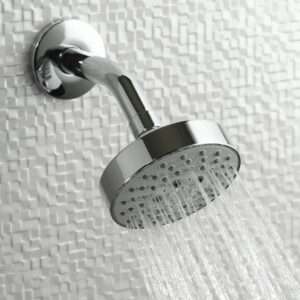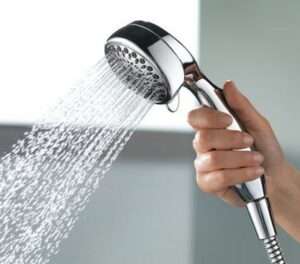A showerhead is an indispensable component of any bathroom, offering a range of design options that cater to individual tastes and bathroom requirements. With an extensive selection of both fixed and handheld models available in the market, one can choose the one that best suits their needs.
From low to high water pressure, there is a showerhead for every preference. If you already have a fixed showerhead installed and prefer a handheld one instead, converting it is a straightforward process.
Fixed Shower Head

A fixed shower head, also commonly referred to as a wall-mounted shower head, is a type of shower fixture that is affixed to the shower arm protruding from the wall.
The design of a fixed shower head allows for ease of use and reliable functionality, as it enables the user to shower with both hands free from the task of holding the shower head.
Replacing a fixed shower head is a simple process that involves unscrewing the old or defective fixture and screwing a new one in its place. It is recommended to securely hold onto the shower arm during the replacement process to prevent any damage or breakage.
Fixed shower heads are available in a wide variety of options and features, including rain, massage, and water-saving features, among others. These options provide users with greater control over their shower experience, allowing them to tailor the water flow to their preferences.
Handheld Shower Head

A handheld shower head is an intelligent choice for those who need to use the shower head at close range, such as when teaching a child how to use the shower without assistance, or when bathing a pet. The handheld shower head is connected to a long hose and is designed to sit in a cradle in the hand for ease of use.
In addition to its primary use as a handheld device, a handheld shower head can also function as a fixed shower head. However, its versatility truly shines when it is detached from its cradle and utilized for other purposes, such as cleaning the bathtub or washing children and pets.
It is important to note that handheld shower heads come in various hose lengths, with some models meeting ADA compliance standards by being at least 84 inches long. This ensures that people of all abilities can comfortably and safely use the shower head.
How to Convert Fixed Shower Head to Handheld
In order to successfully convert your fixed shower head into a handheld one, it is imperative that you take the necessary preparation and starting steps. One crucial step is to ensure that the handheld version you intend to install is compatible with the holder bracket already installed on your bathroom wall.
Once compatibility has been established, the next step is to gather all the required tools for the job, including adjustable pliers, an adjustable wrench, and plumber’s tape. These tools will be essential for achieving a seamless and secure installation process.
Recommended Post:- A Guide to Replacing Your Shower Head
The Procedure
To replace your old shower head, it’s important to take certain precautions to protect the chrome finish. First, wrap a piece of tape around the teeth of your pliers to prevent them from damaging the metal.
Using these protected pliers, turn the old shower head counterclockwise until it comes off. Alternatively, you can use an adjustable wrench wrapped with a cloth to protect the chrome.
Next, clean the shower threads and remove any rust or dust. To remove limescale, use vinegar on the arm of the shower, being careful not to spread it to the new shower head and hose as it can affect their performance.
To install the new shower head, attach the compatible handheld shower mounting bracket to the arm of the shower with the side with the outlet facing down and the side with the holder facing up. Tighten it with an adjustable wrench, being careful not to overtighten it.
Then, attach the hose to the bracket with the shorter end facing downward and the longer end attached to the shower head. Both ends of the hose should have in-built washers, allowing you to tighten them by hand.
Finally, connect the shower head to the end of the hose and ensure it is stable in the holder. Check that everything is tightened enough to prevent leaks and hang the new shower head in the new bracket.
By following these steps, you can replace your old shower head with a new one while protecting the chrome finish and ensuring proper functionality.
Recommended:
All Metal Dual Shower Head with Handheld
How to Clean Inside Shower Hose
Best Shower Faucet for Seniors
FAQS
How often should you change your shower head?
Ideally, a shower head should be replaced after every six to eight months. The bathroom tends to have a warm and wet environment which makes it a good spot for germs.
In particular, shower heads can build up sediments from bacteria, tap water, and mold.
Shower heads are bacterial breeding grounds that can lead to respiratory illnesses. Regular cleaning can extend a shower heads life but those with a lower immunity system should be watchful.
Potentially harmful bacteria such as Ecoli and Streptococcus can lurk in every part of the shower head.
Depending on the frequent use of the shower head in your home the shower head can last longer with a monthly deep clean.
Take a sandwich bag and fill it with white vinegar and then submerge the shower head in it for an hour and rinse.
How do I know if my shower head is bad?
There are various warning signs that indicate that your shower head is bad. The first is a change in water pressure such that the water pressure has gotten weak or it wildly fluctuates.
At times the water pressure change can be attributed to the head getting lose. That can be fixed by tightening it. In other instances, the head has just simply worn out due to usage affecting how it controls water pressure.
The second is constant dripping but you need to verify that the leak is coming from the shower head. At times the dripping may be caused by washer rings that have been worn out or supply valves.
Ensure that the two are not responsible for the leak before replacing your shower head.
The third is sediment build-up that is caused by additives and chemicals that are filtered out by the shower heads.
Inside the shower heads there are screens responsible for the filtration and over time they can get dirty causing sediment build up around and in the shower head.
The fourth is black mold caused by hard water staining. Check the shower head to see if black spots have formed on its head.
Those spots are black mold which is toxic and has the capability of causing damaging effects to your health.
Why does my new shower head drip after I turn it off?
When you turn on the shower water and the shower diverter level up, the water will be directed and forced up the standpipe of the shower, then to the shower arm, and then to the shower head.
Once the shower is turned off the diverter level of the shower will be pushed down and the excess water remaining in the vertical standpipe will fall backward.
That will cause most of the water to drain to the tub and an airlock will develop in the pipe trapping water in the shower arm’s horizontal portion and in the shower head.
The air that usually helps in completely flushing out the water once the diverter level is pushed down, may the restricted by a flow restrictor in the shower head. Therefore, water will drip from the shower head when it is turned off.
The problem can be remedied by manually draining the system to stop the dripping. The procedure could be a nuisance but it only takes less than a minute.
Are all shower heads Universal?
Almost all shower heads in the United States have the same connections as the standard is half-inch NPT. That means you can place any shower head on your shower arm plumbing, whether it’s on the ceiling or the wall.
However, there are exceptions to the rule, as various threads are used in different places around the world.
Secondly, you may find showers with unconventional shower heads that you should avoid unless you plan to make substantial changes in your plumbing at home.
Examples include a rainfall shower with a ceiling installation that is too wide to hold a wall-mounted shower arm, which is common in most people’s homes.
The differences show that every shower head is not universal, even if it has some common characteristics.
Recommended Post: